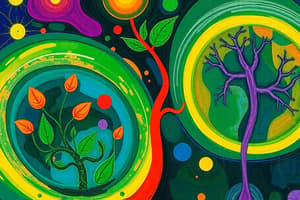Podcast
Questions and Answers
Which of the following statements accurately describes the relationship between photosynthesis and cellular respiration?
Which of the following statements accurately describes the relationship between photosynthesis and cellular respiration?
- Photosynthesis and cellular respiration both produce glucose and oxygen.
- Photosynthesis consumes carbon dioxide and water, while cellular respiration produces glucose and oxygen.
- Photosynthesis and cellular respiration both consume carbon dioxide and water to produce energy.
- Photosynthesis produces glucose and oxygen, while cellular respiration consumes glucose and oxygen. (correct)
Fermentation always requires the presence of oxygen to produce energy.
Fermentation always requires the presence of oxygen to produce energy.
False (B)
What are the primary reactants of photosynthesis?
What are the primary reactants of photosynthesis?
Water and Carbon Dioxide
In cellular respiration, glucose is initially broken down in the ______.
In cellular respiration, glucose is initially broken down in the ______.
Match each process with its primary product:
Match each process with its primary product:
Which type of fermentation is responsible for the burning sensation in muscles during intense exercise?
Which type of fermentation is responsible for the burning sensation in muscles during intense exercise?
The chemical equation for photosynthesis is the reverse of the chemical equation for fermentation.
The chemical equation for photosynthesis is the reverse of the chemical equation for fermentation.
What is the role of chloroplasts in photosynthesis?
What is the role of chloroplasts in photosynthesis?
In alcoholic fermentation, ______ is produced, causing bread to rise.
In alcoholic fermentation, ______ is produced, causing bread to rise.
Match the following energy processes to their primary location in the cell:
Match the following energy processes to their primary location in the cell:
Which of the following is a product of cellular respiration?
Which of the following is a product of cellular respiration?
Photosynthesis primarily occurs in animal cells.
Photosynthesis primarily occurs in animal cells.
What is the main purpose of cellular respiration?
What is the main purpose of cellular respiration?
The equation for photosynthesis uses light energy to convert carbon dioxide and water into ______ and oxygen.
The equation for photosynthesis uses light energy to convert carbon dioxide and water into ______ and oxygen.
Match the type of fermentation with its characteristic process:
Match the type of fermentation with its characteristic process:
During intense exercise, which process allows muscle cells to continue producing energy when oxygen is limited?
During intense exercise, which process allows muscle cells to continue producing energy when oxygen is limited?
Cellular respiration produces oxygen as a byproduct.
Cellular respiration produces oxygen as a byproduct.
What role do single-celled organisms, such as yeast, play in alcoholic fermentation?
What role do single-celled organisms, such as yeast, play in alcoholic fermentation?
The products of photosynthesis are glucose and ______.
The products of photosynthesis are glucose and ______.
Match the term with its correct description:
Match the term with its correct description:
Flashcards
Photosynthesis
Photosynthesis
The process by which cells capture energy from sunlight and use it to produce food.
Purpose of Photosynthesis
Purpose of Photosynthesis
Organisms obtain energy from sunlight captured during this process; it also produces most of Earth's oxygen.
Photosynthesis Reactants and Products
Photosynthesis Reactants and Products
Water and carbon dioxide are used, and oxygen and glucose are produced.
Photosynthesis Chemical Equation
Photosynthesis Chemical Equation
Signup and view all the flashcards
Cellular Respiration
Cellular Respiration
Signup and view all the flashcards
Cellular Respiration Reactants
Cellular Respiration Reactants
Signup and view all the flashcards
Cellular Respiration Products
Cellular Respiration Products
Signup and view all the flashcards
Cellular Respiration Chemical Equation
Cellular Respiration Chemical Equation
Signup and view all the flashcards
Photosynthesis vs. Cellular Respiration
Photosynthesis vs. Cellular Respiration
Signup and view all the flashcards
Fermentation
Fermentation
Signup and view all the flashcards
Alcoholic Fermentation
Alcoholic Fermentation
Signup and view all the flashcards
Lactic Acid Fermentation
Lactic Acid Fermentation
Signup and view all the flashcards
Study Notes
- Understanding photosynthesis, cellular respiration, and fermentation is key to understanding how living organisms obtain and use energy.
- Photosynthesis is the primary source of energy and oxygen for life on Earth.
- Cellular respiration and fermentation allow organisms to break down food molecules to release energy.
Photosynthesis: Definition
- The process by which cells capture energy from sunlight and use it to make food.
Photosynthesis: Purpose
- Nearly all living organisms obtain energy directly or indirectly from sunlight through photosynthesis.
- Most of the oxygen in Earth's atmosphere is produced by photosynthesis.
Photosynthesis: Process Overview
- Chloroplasts in plant cells capture sunlight for energy.
- Water (H2O) and Carbon Dioxide (CO2) are required.
- Reactions occur within chloroplasts.
- Oxygen (O2) and Glucose (C6H12O6) are produced.
Photosynthesis: Reactants and Products
- Reactants: Water and Carbon Dioxide
- Products: Sugar (Glucose) and Oxygen
Photosynthesis: Chemical Equation
- 6CO2 + 6H2O + light energy → C6H12O6 + 6O2
Cellular Respiration: Definition
- The process by which cells extract energy from glucose.
Cellular Respiration: Process Overview
- Food is consumed and broken down into smaller molecules by the digestive system.
- Molecules travel from the digestive system into the bloodstream and reach cells.
- Initial glucose breakdown occurs in the cytoplasm.
- Further breakdown occurs in mitochondria and requires oxygen, releasing substantial energy.
- Carbon dioxide and water are produced and expelled from the cell.
Cellular Respiration: Reactants and Products
- Reactants: Sugar (Glucose) and Oxygen.
- Products: Water and Carbon Dioxide.
Cellular Respiration: Chemical Equation
- C6H12O6 + 6O2 → 6CO2 + 6H2O + energy
Cellular Respiration: Comparison with Photosynthesis
- Photosynthesis equation is the reverse of cellular respiration.
- Photosynthesis converts CO2 and H2O to sugars and O2 using light energy.
- Cellular respiration converts sugars and O2 back into CO2 and H2O, releasing energy.
Fermentation: Definition
- The process by which cells release energy without using oxygen.
Fermentation: Types
- Alcoholic Fermentation
- Occurs in yeast and some single-celled organisms.
- Produces alcohol, carbon dioxide, and a small amount of energy.
- Bakers use it to create gas pockets in dough, making bread rise.
- Lactic Acid Fermentation
- Occurs when muscle cells need more oxygen than available.
- Cells break down glucose without oxygen, producing lactic acid.
- Lactic acid provides temporary muscle energy, and contributes to muscle soreness after intense exercise, dissipating within an hour.
Conclusion
- Photosynthesis, cellular respiration, and fermentation are interconnected processes essential for life.
- Photosynthesis captures and converts solar energy into chemical energy, producing oxygen and food.
- Cellular respiration and fermentation harness this energy to power cellular functions.
- These biochemical pathways show the interdependence of life forms on Earth.
Studying That Suits You
Use AI to generate personalized quizzes and flashcards to suit your learning preferences.




